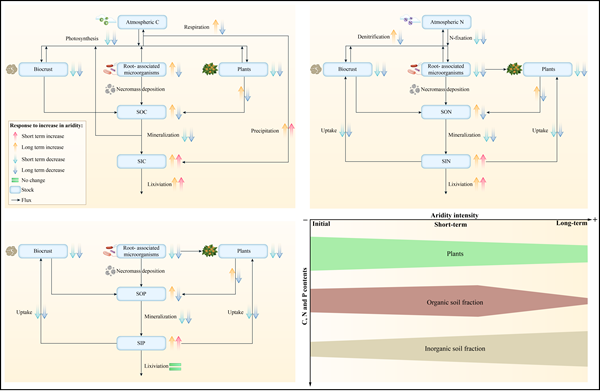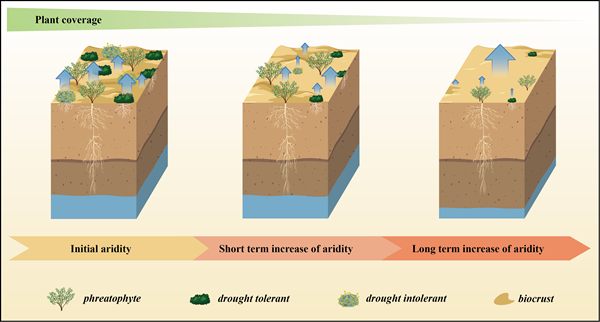Increasing Aridity Impacts Carbon-storing Capacity, Biodiversity Loss, and Ecosystem Services
2024-04-22
In a study published in Global Change Biology, researchers led by Prof. ZENG Fanjiang from the Xinjiang Institute of Ecology and Geography of the Chinese Academy of Sciences have provided valuable insights into the effects of changing aridity on plant-soil systems and biodiversity in arid regions.
Long-term (<15–20 years) increases in aridity in current drylands have reduced carbon, nitrogen, and phosphorus content in plant biomass and the soil organic fraction. In contrast, the inorganic fractions of these three elements have increased, primarily in forms unavailable to plants and microbes. This decline in biologically active carbon and nutrients, coupled with reduced water availability, hinders the potential for regeneration and weakens the ability of plant-soil systems to adapt to and withstand further aridity.
As aridity increases in arid lands, plant communities lose cover and diversity, except for plants with access to the water table. Under more arid conditions, non-drought-tolerant species disappear, and drought-tolerant species tend to persist, often with the protection of phreatophyte species. In the most extreme arid conditions, if the water table is affected, all remaining species are impacted, and phreatophytes may lose part of their aboveground biomass, resulting in very sparse cover.
A feedback loop is triggered when warming is accompanied by increased aridity in current arid lands. Certain land uses, such as overgrazing and fire, exacerbate this effect, leading to reduced plant coverage, lower biocrust, and soil roughness. This, in turn, increases albedo, which tends to decrease precipitation and intensify aridity, reinforcing the loop.
Frequent increases in aridity, often accompanied by inappropriate land use in drylands, reduce available soil organic matter, nutrients, water, and biodiversity and hinder restoration processes, affecting the provision of various ecosystem services.
"Responses to changing aridity are heterogeneous, and more research is needed to better understand the varying impacts on different arid ecosystems," said Dr. Akash Tariq, first author of the study.
"By 2100, half of the world's landmass may become dryland, creating significant challenges for maintaining essential services, impacting human well-being, and raising global and regional socio-political issues,” he added.
The study highlights the impact of increasing aridity in arid lands on the global biogeochemistry in plant-soil systems and climate change across different scales.
Article link:https://onlinelibrary.wiley.com/doi/full/10.1111/gcb.17292

Short-term and long-term changes in carbon (C), nitrogen (N), and phosphorus (P) content in plants, biocrust, and root-associated microorganisms, in soil in organic forms (SOC, SON, and SOP) and in inorganic forms (SIC, SIN, and SIP). (Image by XIEG)

Impact of aridity rise on different plant groups and biocrust in arid lands. (Image by XIEG)

Increasing temperature (Temp) and evapotranspiration (ET) and/or decreasing precipitation, the coverage, and the soil water content (SWC), the biocrusts and the surface roughness decrease in arid areas. (Image by XIEG)
Contact
LONG Huaping
Xinjiang Institute of Ecology and Geography
E-mail: longhp@ms.xjb.ac.cn
Web: http://english.egi.cas.cn



